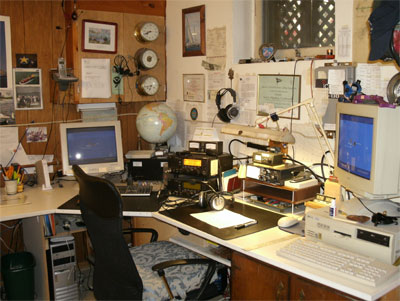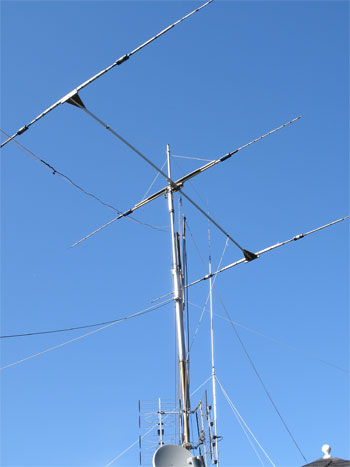After more than 25 years, the oscillator of Herb Hilgenberg’s Icom M710 radio is at rest, the antenna no longer pushing electrostatic waves across the sea. Hilgenberg, a well-known and widely heard amateur weather forecaster and router for vessels in the North Atlantic, has hung up his headphones. His decision to step down was driven both by the steady advance of technology and by the relentless assault of time on the finite span of human strength.
Hilgenberg’s weather broadcasts were not only used by voyaging and racing sailors crossing oceans, he fulfilled a needed role for the Canadian and U.S. Coast Guards and the U.S. Navy during a key period after the end of the Cold War and before the ubiquity of satellite communications and digital weather data. He has plaques and letters from all three organizations testifying to these valuable contributions. That, plus the heartfelt thanks of countless ocean sailors who both communicated with him and just listened in as others did so.
 |
|
Herb Hilgenberg |
|
Hilgenberg's weather broadcast control room. |
Eventually, technology changed the type and availability of weather data products available to the mariner and Hilgenberg’s value to oceangoing voyagers started to wane. It became easier get gridded binary (GRIB) weather files and weather satellite images via e-mail and even Nexrad weather radar data closer inshore.
Time had a hand in Hilgenberg’s decision, too. Even as dedicated a worker as Hilgenberg — who usually started his weather analysis every day in the early afternoon and who stayed on the air from 4 p.m. until the last boat checked in at 8 p.m. or so — couldn’t bely the effects of 25 years. At age 76, he admits he might have gotten a little old for the physical exertions of his singular hobby.
Hilgenberg’s involvement in ocean weather started with his own voyaging aspirations. He and his wife purchased a Corbin 39 bare hull. They finished it themselves while Hilgenberg worked as the CEO of a computer company. The family decided to go cruising and departed Burlington, Ontario, in 1982. Arriving in Sandy Hook, N.Y., Hilgenberg stayed inshore until they got to Beaufort, N.C. Along with another 20 or so boats, Hilgenberg decided to wait until the weather forecast indicated a window to cross the Gulf Stream to Bermuda. After a time the group decided they had their window and departed. About 10 hours after leaving, they got hammered by a storm. According to Hilgenberg, “Several boats we left with didn’t make it.”
Before this first trip to Bermuda, Hilgenberg had not yet made any special study of weather. That began to change. In Bermuda he met a U.S. Navy officer who recommended Hilgenberg get himself an HF SSB radio (his boat was only fitted with a short-range VHF radio).
Equipped with the SSB, a fax modem and a growing knowledge of weather, Hilgenberg began broadcasting weather info in the Caribbean. “I got more involved in weather,” Hilgenberg said. “I was doing a VHF forecast to the boats I was with.”
A year later Hilgenberg was back in Toronto when he received a job offer to work in Hamilton, Bermuda. By 1984 he and his family were living in a house next door to the Royal Hamilton Dinghy Club and had his yacht on a dock in his back yard. He noticed that boats frequently got into trouble on the way to the island. “A week didn’t pass without boats getting lost. I asked ‘How can this be happening?’”
 |
|
Herb Hilgenberg |
|
Hilgenberg’s antenna setup, including the beam antenna he built himself, at his house in Canada. |
He got a ham radio and a marine SSB for his boat and began going on the air. Sailors en route to Bermuda began to hear his now famous call sign, “South Bound II” come up on marine SSB frequencies. Hilgenberg would study weather and then walk down to his boat and settle in for weather broadcasts to mariners at sea. Boaters soon took notice and so did the higher ups. Someone from NOAA in Washington called. “We want your ship reports,” they said. Then the U.S. Navy called asking for his weather reports. In the period from 1990 to 1994, Hilgenberg provided 14,000 weather packages to NOAA and the USN.
By 1994, Hilgenberg’s job in Bermuda ended and as a result his residency permit would also expire. At the time the U.S. Navy was closing down its base in Bermuda after the Cold War. The USN actually made the suggestion to the Bermudian government that it hire Hilgenberg as its own in-house weather forecaster. Bermuda declined and Hilgenberg returned again to Toronto.
Hilgenberg had no plan to continue forecasting, but he soon started receiving phone calls from strangers. “People called up for my weather forecast.”
He was ready to start up again, but there was a problem: his license to operate was for a marine HF SSB radio and his house in Toronto was clearly not a boat. “I asked Canada for a license to operate from my house.”
About six months later, in November 1994, Canada granted him a special license authorizing him to operate on five frequencies: 4, 6, 8, 12 and 21 MHz. Hilgenberg’s weather service was back in business. His traffic grew from an initial 20 boats or so checking in each day to 50, then 60 and eventually 70 boats checking in and asking for his advice on weather routing.
Hilgenberg maintained this level of service every day except for the major holidays, until about 2005 when he noticed traffic starting to fall off. “Things started to slow down because GRIB files and weather data via e-mail became available at sea.” Normal traffic was still an impressive 30 to 50 boats.
Now that he has ended his regular service, Hilgenberg only takes on an occasional boat when the owner is someone he knows and has worked with before. He also will take calls from the Canadian and U.S. Coast Guard when he can help in a emergency situation. “I think my proudest moments were when I was able to keep boats out of danger.”
In addition to Hilgenberg’s Icom M710 radio and computers and fax machines in his home broadcast studio, he is well set up with four antennas: a beam antenna he built himself, a dipole for broadcasting at 8.4 MHz, a dipole set up for 12.359 MHz and a 47-foot high vertical antenna allied with an Icom automatic tuner that allows him to use it for any frequency he needs.

